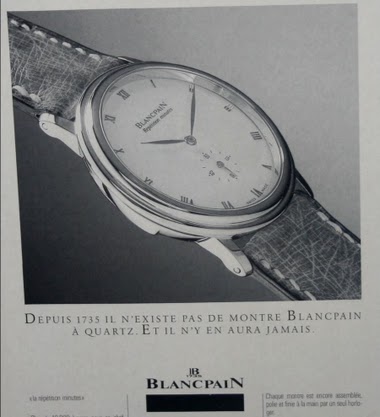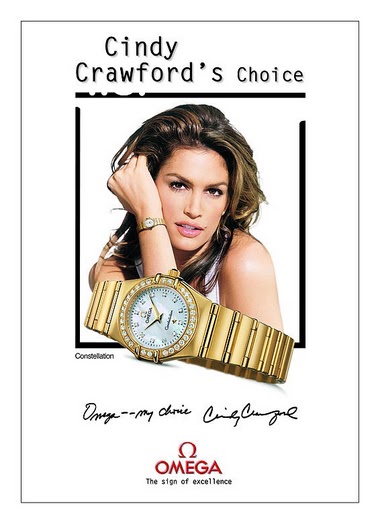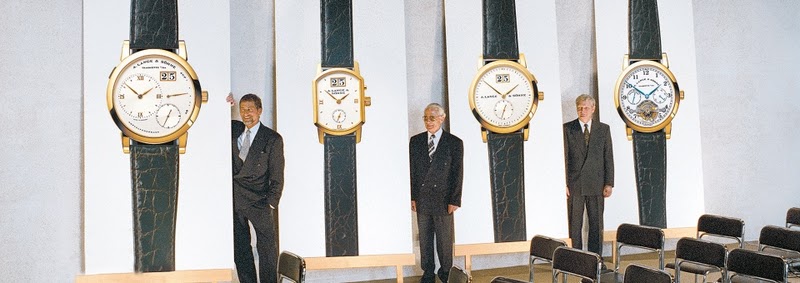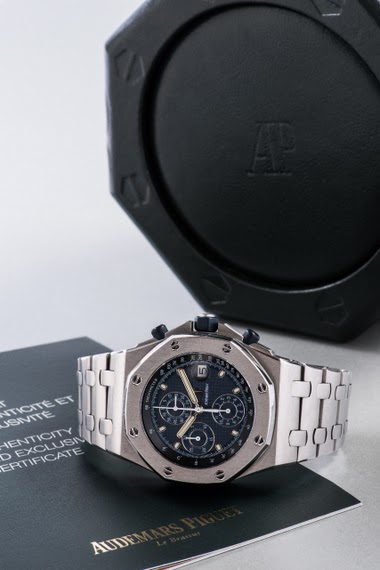
Joepny
1970

Decollage: Patek Philippe, Audemars Piguet, and the big players during the 1990s
KMII and Magnus recently posted threads highlighting a few watches from the 1990s. Coincidentally enough, I have been thinking frequently about the Go-Go 90s ever since I took possession of my 1995 AP RO QP this summer. I’m guessing that the average age on PPro is somewhere in the 50’s, so most of you were growing into your careers 25+ years ago and perhaps had started collecting watches; as for others on PPro, it was a time of our formative university years & entry into the workforce and our awareness of horology may have been slight. Whatever the case, my post is an argument that the Swiss horological world in the 1990’s is an important time to revisit and of course it laid the foundation for our modern 2017 reality and I want to highlight what happened from a business perspective. For some of you active in the watch world in the 1990’s, this would be well known. I am going to appropriate a French word to make it sound more elegant, decollage — this period is the decollage. The horological world in Europe was taking off during the last decade of the 20th century.
Before we start this amateur retrospective tour, I readily admit flaws & omissions because it will neither be fully academic nor comprehensive, but I do encourage and welcome all your corrections and input.
So let’s set the landscape at the start of the decade : the Cold War has ended; the USSR was dissolving and its sphere of influence over Eastern Europe collapsed; Germany would begin its reunification; a British computer scientist developed the underlying technologies for the World Wide Web; the Asian tiger economies were experiencing remarkable economic growth; MTV was a pop culture powerhouse; CNN had introduced viewers to global around-the-clock coverage of news; China was turbocharging its economic reform and industrial privatizations; in the US, the Dow Jones industrial average had grown about 60% since the Black Monday event from Oct 1987.
In the Swiss horological world in 1990, the Swatch Group (SG) was the biggest player (not legally named Swatch Group until later in the decade), its total gross sales were about $2 billion CHF (unadjusted for inflation). Nicolas Hayek was taking control of SG from the Swiss banks that had given them a lifeline a decade earlier at the trough of the quartz crisis. The Swiss banks had taken major risks to plough capital into money losing watch operations. Nicolas Hayek’s background was not in watchmaking, he was a management consultant who had a vision for reviving SG. At the time, SG’s watch brand jewels were Omega and Longines, but its true engine was Eta SA, the movement manufacturer for much of the Swiss watch industry. In 1992, SG bought a prestige heritage brand whose fortunes had been revived in the late 1980’s - Blancpain. The predecessor company of SG had owned the dormant Blancpain but sold off the intellectual property in 1981 before Nicolas Hayek’s tenure, so this was sort of going full circle in a decade’s time. Blancpain had been revived and turned around by Jacques Piguet and a young manager named Jean-Claude Biver who had previously worked at Audemars Piguet and Omega. JC Biver had the insight to staunchly position Blancpain with the heritage of fine mechanical watchmaking & craftsmanship at a time when Swiss watch companies were struggling to be all things to all consumers (thousands of models and price ranges from cheap to extravagant, even Patek Philippe and Audemars Piguet were churning out quartz watches). Blancpain, powered by the movement makers at Frederic Piguet, would produce traditional classic mechanical watches that had the flourish of high-end craft. JC Biver made a bet to be contrarian in the marketplace and to sell to those who identified themselves as differentiators to the 1980s mainstream. It worked, there were people who wanted to own high end mechanical watches and wanted to identify themselves with craftsmanship. (In our decade of the 2010’s the watch blogs would have us believe that we present day watch lovers are a unique contrarian set — plus ca change, plus la meme chose.) JC Biver is credited with the vision for the legendary slogan “Since 1735, there has never been a quartz Blancpain watch. And there never will be.” These two sentences ideally encapsulated what the best of luxury goods should mean: emotional commitment from the maker to you, exclusivity, heritage, and timelessness.

(Blancpain ad copied from Ebay seller “web-cup”)
Next, within SG, JC Biver was given the oversight of Omega’s re-positioning. SG would hone & refine the marketing of watch brands as luxury goods with their own non-overlapping brand identities (also consumer identities) at specific price points. They would not primarily compete on the value/cost equation to consumers. Blancpain was the prestige luxury maison, Omega would be the accessible luxury brand, and the other watch brands fell into other well-defined categories/price points. Omega was positioned to compete with Rolex in the biggest watch segment — high volume, precise Swiss watches with the cachet of heritage and status that cost a few thousand dollars: aspirational luxury. This was the segment that required the most marketing and JC Biver was to cement his master marketer touch during this run. In 1995, Omega entered into a marketing partnership with the Bond movie franchise. Omega would sign celebrity ambassadors such as Cindy Crawford, at the time one of the most famous faces in the world, and Michael Schumacher, a rising star in car racing. As a consequence that SG chose Omega for greater investment, its historic chronometric rival Longines was re-positioned to a lower tier because SG would not have its brands directly compete with one another. In 1996, SG opens its first flagship store in New York dedicated to a single watch brand - the fashion watch Swatch - and hundreds more flagship stores followed. Omega would get its own flagship stores after the turn of the century. By 1999, an ascendant Omega was still outsourcing movements from Lemania and the owner of Lemania had put it up for sale along with other assets. (Lemania had been sold off from SG also back in the early 1980’s.) To keep access to these movements, SG purchased back Lemania along with a struggling watch brand with a pedigree at the pantheon of watchmaking - Breguet.

(1997 ad copied from Omega official website)
Breguet was a shell of its glorious royal past, bankrupt with its parent, in 1987 when it was purchased by Investcorp. Investcorp was a Middle Eastern investment company that at the time was focused on luxury goods icons. They built up a portfolio of watch companies, among them Breguet and Ebel. In 1991, Investcorp purchased Lemania to ensure access to movements for their watch brands. Investcorp kept Breguet afloat and in business but they did not have the Midas touch with luxury watch brands as they had with other golden investments like Tiffany & Co. and Gucci. For me, the most notable watch from Breguet under Investcorp stewardship was the re-introduction of the Type XX watch in 1994 because it has lasted virtually unchanged as Breguet’s entry level sports watch. But it was a lackluster decade for Breguet because they could not match their historical peers like Patek Philippe and Audemars Piguet who had made investments to make their own movements more than a decade before. And then another luminary thought long lost rose out of Glashutte, Germany that changed the game completely for haute horlogerie.
After the fall of the Berlin Wall, Walter Lange set out to restore his ancestors’ watch company in 1990 with funding and managerial expertise from the watchmaking division (to be named LMH) of the German conglomerate Mannesmann VDO. LMH had already owned a controlling interest in Jaeger LeCoultre (in 1986 Mannesmann VDO sold 40% of Jaeger LeCoultre to Audemars Piguet for capital reinvestment) and full ownership of IWC and their leader during the previous decade was Gunter Blumlein. Blumlein had successfully managed Jaeger LeCoulter and IWC into healthy operations but he shared a vision of restoring German fine watchmaking back to strength and with Walter Lange, they began the work to rebuild A. Lange & Sohne (ALS). LMH had controlling ownership and would use its resources and facilities to help ALS build up its watchmaking capabilities again. The revitalized watchmakers from Saxony would learn modern watchmaking from their German-speaking peers in Schaffhausen. And in the fall of 1994 in Dresden, Lange presented four remarkable watches in yellow gold with newly developed movements that received widespread acclaim. All of their modest inventory were sold and the orders would continue to come in. ALS would steadily ramp-up their production while making enhancements and introducing new references. In 1999, another big bang event took place when the new ALS manufactured chronograph movement was unveiled in the form of the Datograph. For decades, the top watch brands had outsourced their chronograph movements by purchasing typically from Valjoux, Lemania or Piguet. ALS had the crown for in-house movements. By the close of the century, it was common to hear watch collectors compare the less-than-a-decade old A. Lange & Sohne to the pinnacle of watch manufacturers, the 160-years-old Patek Philippe.

(the iconic 1994 ALS unveiling, pic from ALS official website)
At the start of 1990, Patek Philippe had completed its 150th anniversary celebrations and enjoyed favorable press with the release of the fantastically complicated Calibre 89 pocket watch. Its estimated gross sales in 1990 were 135 million CHF (unadjusted). Additionally, Patek was riding a rising wave of vintage wristwatch popularity. The European auction houses had historically sold more pocket watches and clocks than wristwatches but in the mid 1980’s vintage wristwatches were becoming highly prized collectibles and Patek Philippe vintage wristwatches were at the forefront. (There had for decades been collectors of pocket watches.) The auction house Habsburg Feldman (subsequently became Antiquorum) created a Patek Philippe only theme auction in 1989. Driven by rumors that Patek Philippe would go bankrupt and dissolve, collectors were looking to capture fine mechanical timepieces that the maison had made. Legacy had even more value than the Swiss industry had previously realized and they paid more attention. (Patek Philippe had been quietly buying back some of its historical watches beginning in the 1970s.) In 1996, Philippe Stern launched two marketing initiatives: the roll-out of the Generations advertising campaign produced by its London advertising agency and the introduction of the Patek Philippe Magazine for its owners. Taken together, the initiatives would emphasize the association of Patek Philippe with connoisseurship and lifestyle choices of a very refined kind. The Generations ad slogan would become: “You never really own a Patek Philippe. You merely look after it for the next generation.” Like the famous Blancpain ad slogan, the Patek slogan communicated heritage and timelessness and then it improved on it by directly communicating to the reader’s psyche — a mechanical object was part of your legacy and it directly connected to your heir. What the slogan subtly did was to affirm the nobility of transferring security (intangible) to your heir with the aspiration of buying a very expensive luxury watch (tangible). Patek Philippe had a staunchly conservative reputation and the marketing initiatives had the great power to turn it to their advantage. Shortly after the turn of the century, the Patek Philippe Museum was opened - another strong emphasis to the legacy of the company. Over in Le Brassus, a historical peer to Patek Philippe was enjoying the fruits of a bold act almost two decades earlier and now were planning a bigger strike against horological conservatism.

(Patek Philippe ad copied from website “Dan’s Watch Collection”)
Audemars Piguet had made two courageous bets during the dark days of the 1970’s: in 1972 they believed that luxury watch buyers would pay a premium for a modern looking sports watch designed by Gerald Genta that was a break from the industry’s perceived norms; in 1978 they invested in developing a perpetual calendar module on top of the thin JLC calibre 920. Both bets proved to be winning as it helped Audemars Piguet remain solvent through the challenging recovery from the quartz crisis. Its estimated gross sales in 1991 were 120 million CHF (unadjusted). The Royal Oak line of watches had become a core element of the Audemars Piguet business: the original time & date RO, the RO QP, the RO day date & moon phase, and the RO dual time. But there was a feeling that the Royal Oak was stale and so in anticipation of the 20th anniversary of the Royal Oak, Audemars Piguet launched a project to refresh it. Introduced a year later than the exact 20th anniversary, the Royal Oak Offshore (ROO) was literally called the beast. Its exaggerated dimensions were striking to the expected conservatism of haute horlogerie. Yet it proved to be a success for Audemars Piguet because there was a segment of luxury watch buyers in the mid 1990’s that wanted masculine boldness cloaked by luxury/status. The success of the original Royal Oak had enabled Audemars Piguet to change the perception of luxury watches and in a surprising way after 20 years, it made a segment of watch buyers tire of it and want something even bolder and so a watch born in 1972 paved the way for its offspring in 1993. Through the remainder of the decade and into this century, Audemars Piguet would use the ROO as a platform to create what were then considered exotic watches with non-traditional colors and neo-modern materials in case design as well as strap design. With the RO and then the ROO, Audemars Piguet has, as much as any other firm, paved the way for more than a few of our current day independent brands that produce large, more exotic, non-traditional luxury watches.

(1987 Audemars Piguet ad copied from Ebay seller “senjiblue2”)

(Royal Oak Offshore - The Beast, not too radical looking now in 2017, pic from Phillips Watches)
Now back to the business side, towards the end of 1999 Vodafone announced their intention to take over Mannesmann VDO in the largest corporate merger in history at the time. Vodafone would subsequently divest its LMH watch division, it did not fit the core mobile phone business. Along with the Swatch Group, two other rivals would make bids - a billionaire South African and a billionaire Frenchman.
We’ll start with the billionaire South African, Johann Rupert. The Rupert family made their first fortune in tobacco in the late 1940s. As the business grew, they diversified into other industries. In the 1970’s, the Rupert family joined with other investors to buy a minority share of Cartier. Johann Rupert started his career as a banker. In 1988, what would become Richemont was incorporated in Switzerland and Johann Rupert began various legal transactions to separate the European luxury goods businesses from his family’s tobacco empire. The 1990’s heralded the democratization of luxury goods through economic, technological, and cultural changes that had pulsed through the world during the previous decade. There was growing wealth, more people had access to credit, and the cachet of luxury permeated widely. This generally meant that once exclusive old world luxury leather goods and fashion brands that catered to the very rich were finding new customers who aspired to and had the means to buy luxury goods from those brands. Of course this applied to the Swiss watch brands too. Luxury goods makers were seen as a growth business if they could modernize to service the growing class of consumers, and those with capital saw the opportunity to consolidate. The perceived advantages of consolidation were very strong because old world luxury needed access to high scale capital and resources necessary to invest in and modernize their businesses and then market and distribute their goods. Richemont was one of those major players with the capital and the luxury watch business was identified for investment. At the start of the decade, Cartier was Richemont’s crown jewel and the watch portfolio also included Piaget and Baume & Mercier. In 1991, the head of Cartier, Alain Dominique Perrin - wanting to elevate the exclusive stature of haute horlogerie and to move away from the unwashed masses at BaselWorld, created the Salon International de La Haute Horlogerie (SIHH). Initially the enthusiasm from the industry was muted and only the 3 Richemont brands were exhibitors along with Gerald Genta and Daniel Roth. The Richemont watch portfolio would grow and the buying spree began with Vacheron Constantin in 1996, purchased from Sheik Ahmed Yamani who was one of the founders of Investcorp. Shortly thereafter in the next year, Richemont completed the acquisition of Officine Panerai. Into the second half of 1999 as the century was drawing closed, Richemont was enjoying record sales growth from its watch brands. When LMH was put up for sale, Johann Rupert was determined to buy them. It was a fierce corporate fight between Rupert and Bernard Arnault, the billionaire controlling owner of LVMH. Rupert outmaneuvered his rival by first entering into agreement with Audemars Piguet to purchase their minority stake in Jaeger LeCoultre. Then Richemont would seal the LMH acquisition by sweetening their final purchase price to around $2.8 billion CHF (unadjusted).
By 1990, Bernard Arnault had been called a Young Wolf by the French press for his aggressive and lawsuit-heavy takeover of Louis Vuitton Moet Hennessy (LVMH). Bernard Arnault came from a family who made their fortune in construction. His strategic vision was that luxury goods brands would disappear with the advantages of size and scale. Once he had consolidated his grip on LVMH, he moved on a steady acquisition spree. However the luxury goods brands controlled by LVMH did not include a dedicated Swiss watch brand for almost the whole decade. Arnault would be late to the game. Perhaps large investments in the cosmetics retailer Sephora and the airport duty free shops empire (DFS) during the middle of the decade had tied up LVMH’s capital and management team. There was also an ill-fated attempt at a hostile takeover of the Gucci Group. The strength of the Swiss luxury watch business as demonstrated by Swatch Group and Richemont in the late 1990’s proved that LVMH needed to jump into the watch sector. They did so with gusto, all in 1999. LVMH purchased Tag Heuer, its first luxury Swiss watch brand. Then it won the bid for Ebel from Investcorp when the Swatch Group balked at the high asking price. Then it bought Zenith. So when Vodafone made the triumvirate of Jaeger LeCoultre/IWC/A. Lange & Sohne available, Arnault had already spent considerable capital. Incidentally, the Ebel acquisition did not become a success — LVMH tried to position it to rival Rolex, similar to what Nicolas Hayek and JC Biver had done with Omega to greater success — and it was sold off within 5 years. LVMH has lacked the prestige crown jewel fine watchmaking brand to this day because Richemont and Swatch Group had snapped up the ones available during the decade of the 1990’s. In contemporary times Bernard Arnault has been ranked as the richest man in France so his unfortunate timing with the luxury watch brands has probably not really hurt that much.
Now you may ask “Fine and dandy about these big boys, but what about the independent watchmakers and where were they during the 1990’s?” I can point you to Elizabeth Doerr’s great article from 2016 as a perfect gateway: quillandpad.com . If anyone wants to argue that Franck Muller (the brand founded in 1991) also gave rise to the contemporary fascination for a certain subset of watch clientele with high complications/limited editions/6-figure prices, the conspicuous consumption watch buyer, I wouldn’t argue with you. So then someone else asks “What about Rolex?” I can say that with all my amateur digging, finding any meaningful discussion about Rolex’s business or directly from Rolex in the 1990’s is as rare as finding a virgin in the same room with a Kardashian.
This message has been edited by KMII on 2017-09-17 00:23:47

Decollage: Patek Philippe, Audemars Piguet, and the big players during the 1990s

Acknowledgements of sources
Don't forget Chopard

Thanks for the input Jim

Thanks joepny. Loved this overview of the brand consolidation. So much intrigue and machinations ( same like other business deals I suppose)

Thanks Julian, the palace intrigue became more visible than in the old history

Can we be honest...



Thank you!



Thanks Bruno

a very good, thorough and accurate post reflecting where the watch industry was before. However some important things to add

Great information as always Georges 👍

Thank you Joepny

Thanks for the kindness Tim

What a difference a few letters makes! I should have studied French to know Décolletage vs Décollage

